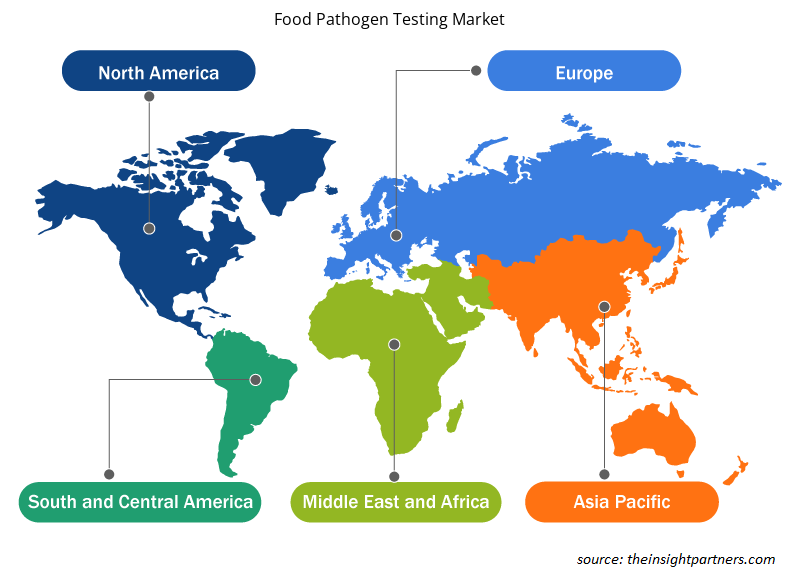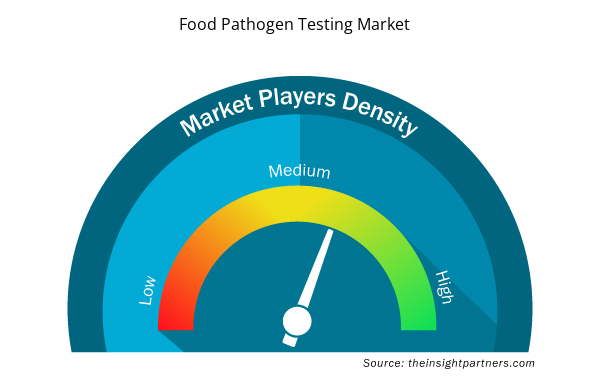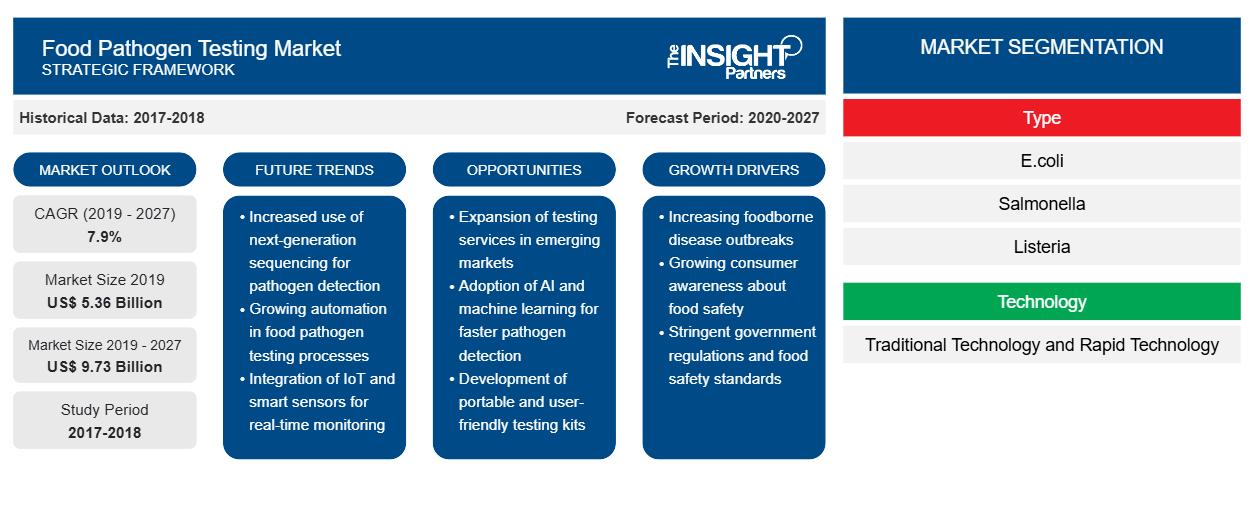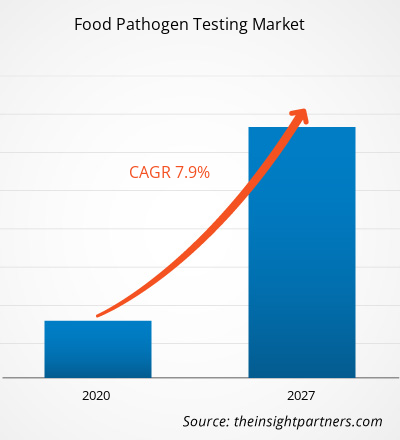2019 年食品病原体检测市场价值为 53.6094 亿美元,预计到 2027 年将达到 97.3191 亿美元;预计 2020 年至 2027 年的复合年增长率为 7.9%。
食品病原体检测是指监测食品中是否存在任何危及生命的细菌或微生物的过程。食品病原体检测对食品行业至关重要,因为已知约有 31 种病毒和细菌会导致有害的食源性疾病。这种检测方法用于食品生产的每个步骤,以确保食品安全。由于食物中毒病例数量增加,安全问题和法规的增加推动了食品病原体检测市场的增长。此外,聚合酶链反应和免疫磁分离等各种食品病原体检测方法的进步以及有限的检测时间有利于食品行业的各个参与者采用食品病原体检测。
预测期内,欧洲食品病原体检测市场预计以最高的复合年增长率增长。该地区市场的增长主要归因于食源性疾病发病率的上升,以及人们对食品安全的认识的提高推动了北美对食品病原体检测的需求。病原体检测方法的发展加上纳米生物技术也支持了市场的增长。医疗费用的增加和转基因生物在食品饮料行业的应用也刺激了市场的发展。食品贸易全球化和经济发展促进了该地区食品病原体检测市场的扩张。食品消费者和制造商对开展食品病原体检测的好处的认识不断提高,为食品病原体检测市场的发展提供了有利可图的机会。
定制此报告以满足您的需求
您可以免费定制任何报告,包括本报告的部分内容、国家级分析、Excel 数据包,以及为初创企业和大学提供优惠和折扣
- 获取此报告的关键市场趋势。这个免费样品将包括数据分析,从市场趋势到估计和预测。
COVID-19 疫情对食品病原体检测市场的影响
由于封锁、旅行禁令和企业停工,COVID-19 疫情对各国的经济和行业产生了不利影响。食品和饮料是遭受严重破坏的重要行业之一,例如供应链限制和生产工厂停工。各国不同工厂的关闭扰乱了全球供应链,并对制造活动、交货时间表和多种商品销售产生了负面影响。多家公司已经宣布产品交付可能延迟,未来产品销售下滑。此外,欧洲、亚洲和北美国家实施的全球旅行禁令阻碍了商业合作和伙伴关系机会。因此,这些因素正在抑制食品和饮料行业食品病原体检测市场的增长。
市场洞察
乳制品生产中快速病原体检测的增加有望推动食品病原体检测市场的增长
随着食品安全技术的发展,食品病原体检测技术不断得到改进和应用。如今,乳制品生产商有多种选择,可以进行准确、快速的病原体检测,适用于不同类别的产品、设施和工作流程。快速食品病原体检测技术基于不同的化学反应,目的是以最有效和最高效的方式检测目标病原体。基于酶联荧光分析 (ELFA) 的技术针对病原体上的特定细胞表面受体进行识别。基于聚合酶链反应 (PCR) 的技术针对每种病原体内的 DNA。
在乳制品厂实施快速检测技术有很多好处,例如可以更快地获得结果,从而进一步提高整个检测过程,以提高生产效率、减少保存时间并延长产品的保质期。使用快速检测技术还有利于更快地应对不良事件,使乳制品生产设施能够实施任何必要的纠正措施,从而防止因浪费和变质造成的损失。此外,这些快速食品病原体检测方法易于使用,并为人员提供了更大的灵活性。大多数乳制品制造商都实施了内部检测计划。通过适当的培训和适当的仪器,高级微生物学学位不再是实施成功病原体检测计划的障碍。此外,快速检测方法的可及性和可负担性的提高,使乳制品制造商能够将数据保留在内部,增强样品和结果的可追溯性和控制。数据的利用和存储进一步帮助制造商采用分析并做出主动决策,从供应链到生产线再到存储设施。由于快速病原体检测具有诸多优势,乳制品制造商在其生产部门中实施该技术,从而促进了食品病原体检测市场的增长。
类型洞察
根据类型,食品病原体检测市场分为漂白食品和天然食品。2018 年,沙门氏菌占据了较大的市场份额,预计在预测期内市场复合年增长率将更高。沙门氏菌是影响人体肠道的最常见细菌性疾病。它会导致腹泻、腹部绞痛和发烧。它主要是由于食用生肉或未煮熟的肉类、家禽和蛋制品而引起的。沙门氏菌感染会削弱免疫系统,尤其是婴儿、妇女和成年人。有时它会危及生命,因此食品病原体检测主要是针对沙门氏菌进行的。感染沙门氏菌的风险非常高,人们很容易被感染。因此,为了防止这种感染和生命损失,食品病原体检测在这一领域发挥着非常重要的作用,这反过来又推动了食品病原体检测市场的增长。
食物类型洞察
根据食品类型,食品病原体检测市场细分为肉类和家禽、乳制品、加工食品、水果和蔬菜以及谷物和谷类。肉类和家禽部分在 2018 年占据了最大的市场份额。全球肉类消费量因其健康益处而大幅增长,例如蛋白质摄入量增加以及户外晚餐支出增加。由于消费者意识和健康意识的增强,改善或保持产品质量的必要性推动了食品病原体检测需求。由于家禽、肉类和海鲜产品中食品病原体爆发的增加,法规的制定促进了该细分市场的增长。与肉类和家禽相关的最重要病原体是大肠杆菌、弯曲杆菌和沙门氏菌。剥皮和去毛过程中的不卫生条件和不当处理会导致污染,预计会支持该细分市场的增长。
技术洞察
根据技术,食品病原体检测市场分为传统技术和快速技术。快速技术部分在 2018 年占据了最大的市场份额。传统技术简单的步骤和较低的初始成本支持了该部分的增长。它具有降低成本和提高准确性等各种优势,这些优势可能会推动该部分的增长。尽管传统技术非常精确,但病原体检测需要相当长的时间。有时需要几天到几周的时间。此外,食品微生物实验室在过去 30 年中发生了重大变化。在 20 世纪 80 年代初期,重点是质量控制测试,由制造商内部完成。然而,随着行业开始采用 HACCP 方法进行食品安全管理,质量控制被质量保证所取代。食品安全控制的目标不是检测,而是预防,其余大部分微生物检测都是外包的。传统技术仍然依赖于培养样本中的微生物来产生足够的细胞进行检测。培养步骤至少需要 24 小时,对于某些病原体来说,培养过程甚至需要 5 天或更长时间。传统方法无法快速提供结果,无法有效监控 HACCP 系统中的关键控制点,目前主要用于验证系统是否正常运行。
食品病原体检测市场中的一些参与者包括 SGS SA、Bureau Veritas、Intertek Group Plc、Eurofins Scientific、Mérieux NutriSciences.、ifp Institut für Produktqualität GmbH、ALS Limited、AsureQuality、Microbac Laboratories 和 FoodChain ID Group Inc 等。主要公司实施并购和研发战略,以扩大客户群并在全球市场中获得显著份额,这也使他们能够在全球范围内保持自己的品牌名称。
食品病原体检测市场区域洞察
Insight Partners 的分析师已详细解释了预测期内影响食品病原体检测市场的区域趋势和因素。本节还讨论了北美、欧洲、亚太地区、中东和非洲以及南美和中美洲的食品病原体检测市场细分和地理位置。

- 获取食品病原体检测市场的区域特定数据
食品病原体检测市场报告范围
| 报告属性 | 细节 |
|---|---|
| 2019 年市场规模 | 53.6亿美元 |
| 2027 年市场规模 | 97.3亿美元 |
| 全球复合年增长率(2019 - 2027) | 7.9% |
| 史料 | 2017-2018 |
| 预测期 | 2020-2027 |
| 涵盖的领域 | 按类型
|
| 覆盖地区和国家 | 北美
|
| 市场领导者和主要公司简介 |
|
市场参与者密度:了解其对商业动态的影响
食品病原体检测市场正在快速增长,这得益于终端用户需求的不断增长,而这些需求又源于消费者偏好的不断变化、技术进步以及对产品优势的认识不断提高等因素。随着需求的增加,企业正在扩大其产品范围,进行创新以满足消费者的需求,并利用新兴趋势,从而进一步推动市场增长。
市场参与者密度是指在特定市场或行业内运营的企业或公司的分布情况。它表明在给定市场空间中,相对于其规模或总市场价值,有多少竞争对手(市场参与者)存在。
在食品病原体检测市场运营的主要公司有:
- 瑞士通用公证行
- 必维国际检验集团
- 天祥集团
- 欧陆科技
- 梅里埃营养科学。
免责声明:上面列出的公司没有按照任何特定顺序排列。

- 了解食品病原体检测市场主要参与者概况
报告亮点
- 食品病原体检测市场的渐进式行业趋势,帮助参与者制定有效的长期战略
- 发达市场和发展中市场采用的业务增长战略
- 2019年至2027年食品病原体检测市场定量分析
- 全球食品病原体检测需求估计
- PEST 分析可说明行业内买家和供应商的效率
- 了解竞争市场状况的最新发展
- 市场趋势和前景以及推动和抑制食品病原体检测市场增长的因素
- 通过强调支撑商业利益的市场策略来协助决策过程,从而促进市场增长
- 各节点食品病原体检测市场规模
- 市场详细概述和细分,以及食品病原体检测行业动态
- 各地区食品病原体检测市场规模及增长潜力分析
食品病原体检测市场-按类型
- 大肠杆菌
- 沙门氏菌
- 李斯特菌
- 弯曲杆菌
- 其他的
食品病原体检测市场 – 按技术
- 传统技术
- 快速技术
食品病原体检测市场 – 按食品类型
- 肉类和家禽
- 奶制品
- 加工食品
- 水果和蔬菜
- 谷物和谷类
公司简介
- 瑞士通用公证行
- 必维国际检验集团
- 天祥集团
- 欧陆科技
- 梅里埃营养科学。
- ifp 产品质量研究所有限公司
- 艾力士有限公司
- 品质保证
- Microbac 实验室
- 食品链 ID 集团公司
- 历史分析(2 年)、基准年、预测(7 年)及复合年增长率
- PEST 和 SWOT 分析
- 市场规模价值/数量 - 全球、区域、国家
- 行业和竞争格局
- Excel 数据集


- Organoids Market
- Medical Enzyme Technology Market
- Mail Order Pharmacy Market
- Single-Use Negative Pressure Wound Therapy Devices Market
- Health Economics and Outcome Research (HEOR) Services Market
- Batter and Breader Premixes Market
- Vertical Farming Crops Market
- Hydrocephalus Shunts Market
- Surgical Gowns Market
- Clear Aligners Market

Report Coverage
Revenue forecast, Company Analysis, Industry landscape, Growth factors, and Trends

Segment Covered
This text is related
to segments covered.

Regional Scope
North America, Europe, Asia Pacific, Middle East & Africa, South & Central America

Country Scope
This text is related
to country scope.
常见问题
Global meat consumption has increased tremendously owing to its health benefits, such as improved protein intake coupled with a rise in spending on outdoor dinners. The necessity to improve or maintain the product quality due to growing consumer awareness and health consciousness drives the food pathogen testing demand. Developing regulations attributed to increasing food pathogen outbreaks through poultry, meat, and seafood products amplify the segment growth. The most important pathogens associated with meat and poultry are E. coli, campylobacter, and Salmonella. Unhygienic conditions and improper handling during skinning and de-feathering results in contamination anticipated supporting this segment growth.
The major players operating in the global pathogen testing market are SGS SA, Bureau Veritas, Intertek Group Plc, Eurofins Scientific, Mérieux NutriSciences., ifp Institut für Produktqualität GmbH, ALS Limited, AsureQuality, Microbac Laboratories, and FoodChain ID Group Inc, among others.
In 2019, the pathogen testing market was predominant in North America at the global level. North America encompasses an ample amount of opportunities for the growth of pathogen testing. The rise in the incidence of foodborne diseases and thus the rising awareness towards food safety drives the demand for food pathogen testing in North America. Development in pathogen testing methods coupled with nano-biotechnology also supports the growth of the market. Increments in medical expenses and the application of genetically modified organisms in food & beverages industry also fuels the market for the same.
Trends and growth analysis reports related to Consumer Goods : READ MORE..
The List of Companies - Global Food Pathogen Testing Market
- SGS SA
- Bureau Veritas
- Intertek Group Plc
- Eurofins Scientific
- Mérieux NutriSciences.
- ifp Institut für Produktqualität GmbH
- ALS Limited
- AsureQuality
- Microbac Laboratories
- FoodChain ID Group Inc
The Insight Partners performs research in 4 major stages: Data Collection & Secondary Research, Primary Research, Data Analysis and Data Triangulation & Final Review.
- Data Collection and Secondary Research:
As a market research and consulting firm operating from a decade, we have published and advised several client across the globe. First step for any study will start with an assessment of currently available data and insights from existing reports. Further, historical and current market information is collected from Investor Presentations, Annual Reports, SEC Filings, etc., and other information related to company’s performance and market positioning are gathered from Paid Databases (Factiva, Hoovers, and Reuters) and various other publications available in public domain.
Several associations trade associates, technical forums, institutes, societies and organization are accessed to gain technical as well as market related insights through their publications such as research papers, blogs and press releases related to the studies are referred to get cues about the market. Further, white papers, journals, magazines, and other news articles published in last 3 years are scrutinized and analyzed to understand the current market trends.
- Primary Research:
The primarily interview analysis comprise of data obtained from industry participants interview and answers to survey questions gathered by in-house primary team.
For primary research, interviews are conducted with industry experts/CEOs/Marketing Managers/VPs/Subject Matter Experts from both demand and supply side to get a 360-degree view of the market. The primary team conducts several interviews based on the complexity of the markets to understand the various market trends and dynamics which makes research more credible and precise.
A typical research interview fulfils the following functions:
- Provides first-hand information on the market size, market trends, growth trends, competitive landscape, and outlook
- Validates and strengthens in-house secondary research findings
- Develops the analysis team’s expertise and market understanding
Primary research involves email interactions and telephone interviews for each market, category, segment, and sub-segment across geographies. The participants who typically take part in such a process include, but are not limited to:
- Industry participants: VPs, business development managers, market intelligence managers and national sales managers
- Outside experts: Valuation experts, research analysts and key opinion leaders specializing in the electronics and semiconductor industry.
Below is the breakup of our primary respondents by company, designation, and region:

Once we receive the confirmation from primary research sources or primary respondents, we finalize the base year market estimation and forecast the data as per the macroeconomic and microeconomic factors assessed during data collection.
- Data Analysis:
Once data is validated through both secondary as well as primary respondents, we finalize the market estimations by hypothesis formulation and factor analysis at regional and country level.
- Macro-Economic Factor Analysis:
We analyse macroeconomic indicators such the gross domestic product (GDP), increase in the demand for goods and services across industries, technological advancement, regional economic growth, governmental policies, the influence of COVID-19, PEST analysis, and other aspects. This analysis aids in setting benchmarks for various nations/regions and approximating market splits. Additionally, the general trend of the aforementioned components aid in determining the market's development possibilities.
- Country Level Data:
Various factors that are especially aligned to the country are taken into account to determine the market size for a certain area and country, including the presence of vendors, such as headquarters and offices, the country's GDP, demand patterns, and industry growth. To comprehend the market dynamics for the nation, a number of growth variables, inhibitors, application areas, and current market trends are researched. The aforementioned elements aid in determining the country's overall market's growth potential.
- Company Profile:
The “Table of Contents” is formulated by listing and analyzing more than 25 - 30 companies operating in the market ecosystem across geographies. However, we profile only 10 companies as a standard practice in our syndicate reports. These 10 companies comprise leading, emerging, and regional players. Nonetheless, our analysis is not restricted to the 10 listed companies, we also analyze other companies present in the market to develop a holistic view and understand the prevailing trends. The “Company Profiles” section in the report covers key facts, business description, products & services, financial information, SWOT analysis, and key developments. The financial information presented is extracted from the annual reports and official documents of the publicly listed companies. Upon collecting the information for the sections of respective companies, we verify them via various primary sources and then compile the data in respective company profiles. The company level information helps us in deriving the base number as well as in forecasting the market size.
- Developing Base Number:
Aggregation of sales statistics (2020-2022) and macro-economic factor, and other secondary and primary research insights are utilized to arrive at base number and related market shares for 2022. The data gaps are identified in this step and relevant market data is analyzed, collected from paid primary interviews or databases. On finalizing the base year market size, forecasts are developed on the basis of macro-economic, industry and market growth factors and company level analysis.
- Data Triangulation and Final Review:
The market findings and base year market size calculations are validated from supply as well as demand side. Demand side validations are based on macro-economic factor analysis and benchmarks for respective regions and countries. In case of supply side validations, revenues of major companies are estimated (in case not available) based on industry benchmark, approximate number of employees, product portfolio, and primary interviews revenues are gathered. Further revenue from target product/service segment is assessed to avoid overshooting of market statistics. In case of heavy deviations between supply and demand side values, all thes steps are repeated to achieve synchronization.
We follow an iterative model, wherein we share our research findings with Subject Matter Experts (SME’s) and Key Opinion Leaders (KOLs) until consensus view of the market is not formulated – this model negates any drastic deviation in the opinions of experts. Only validated and universally acceptable research findings are quoted in our reports.
We have important check points that we use to validate our research findings – which we call – data triangulation, where we validate the information, we generate from secondary sources with primary interviews and then we re-validate with our internal data bases and Subject matter experts. This comprehensive model enables us to deliver high quality, reliable data in shortest possible time.


 获取此报告的免费样本
获取此报告的免费样本